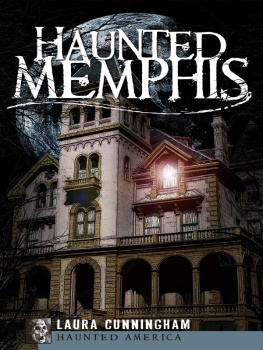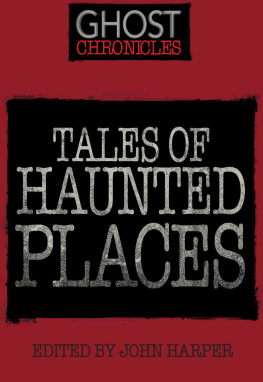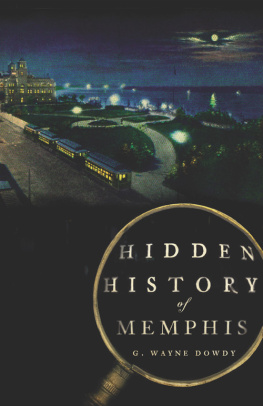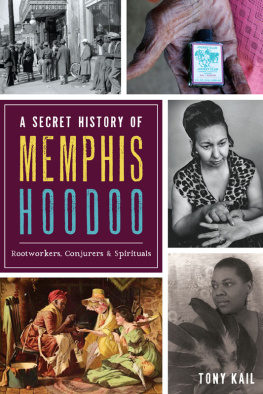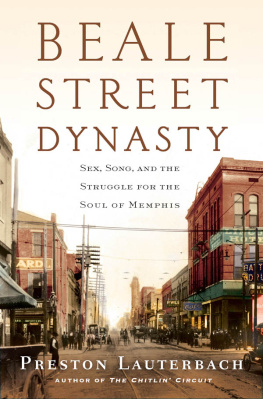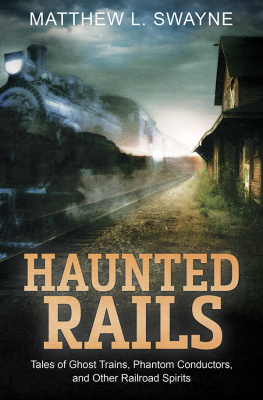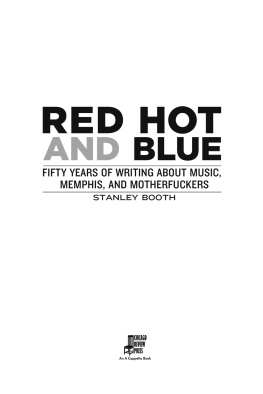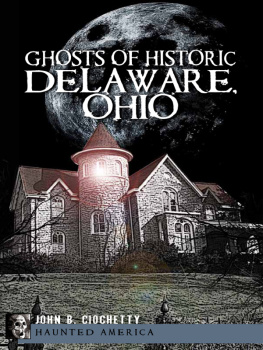

Published by Haunted America
A division of The History Press
Charleston, SC 29403
www.historypress.net
Copyright 2009 by Laura Cunningham
All rights reserved
All images courtesy of the Memphis and Shelby County Room, Memphis Public Library and Information Center, unless otherwise stated.
First published 2009
Second printing 2011
Third printing 2011
Fourth printing 2012
e-book edition 2013
Manufactured in the United States
ISBN 978.1.62584.268.8
Library of Congress Cataloging-in-Publication Data
Cunningham, Laura.
Haunted Memphis / Laura Cunningham.
p. cm.
Includes bibliographical references and index.
print edition ISBN 978-1-59629-712-8 (alk. paper)
1. Ghosts--Tennessee--Memphis. 2. Haunted places--Tennessee--Memphis. I. Title.
BF1472.U6C86 2009
133.10976819--dc22
2009026207
Notice: The information in this book is true and complete to the best of our knowledge. It is offered without guarantee on the part of the author or The History Press. The author and The History Press disclaim all liability in connection with the use of this book.
All rights reserved. No part of this book may be reproduced or transmitted in any form whatsoever without prior written permission from the publisher except in the case of brief quotations embodied in critical articles and reviews.
For Dick, Carolyn, Joyce and Eli
CONTENTS
ACKNOWLEDGEMENTS
There are several individuals or institutions I would like to thank for the assistance they provided me with while working on this book.
I wish to thank my parents, Jim and Lela Cunningham, and my sister, Anna Edmondson, for providing me with the unconditional support I needed, not just for this book but throughout all aspects of life. I would also like to thank my family for watching over my spirited two-year-old son, Eli Morrison. Without that assistance, this book might never have been completed.
I would also like to thank Wade Murphy, Brent Armour, Corey Cochran, Leigh Rast and Dr. Jonathan Weems. Thank you all for having such contagious excitement for me. Thank you for your encouragement and for believing in me.
I would also like to thank the staff of the history department at the Memphis Public Library and Information Center. Their knowledge and assistance in locating information proved invaluable during this experience. I would especially like to thank Gina Cordell for suggesting that I might be interested in writing about Memphis history.
I would also like to thank G. Wayne Dowdy, author and archivist for the Memphis and Shelby County Room. Thank you for helping to arrange this book and assisting with any question I had. Your encouragement to preserve this form of local folklore became the driving force for this project.
INTRODUCTION
In December 2008 I decided I was going to write a book about Memphis ghost stories. I had been contemplating the idea for quite some time, but only then did I begin thinking that it was something I might actually be able to do. I began telling people I was going to write a book, and the reactions were mixed. I spent several years working in downtown museums and also conducting historic walking tours throughout Memphis. Through these experiences, I began collecting local ghost stories and sharing this information with others. Each time I was asked to tell a ghost story, I became more convinced that these stories were an important form of folklore and needed to be preserved.
Memphians are naturally curious about these familiar locations, and ghost stories have an enduring appeal. The stories I have selected for this book have been included because of their significance in Memphis history. These stories have either been documented in some form or shared by word of mouth. With any type of folklore, each story has some variation in the details. These stories are legendsstories that were originally told as fact and have been embellished with each retelling.
As a historian, my job was to research and evaluate hundreds of documents and official records that pertain to the people and places involved in these stories. As a writer, my job was to relay this collection of Memphis ghost lore in what I hope is an entertaining and informative format.
I cannot prove or disprove the existence of ghosts in Memphis, nor is it my intention to do so. My ultimate purpose is simply to preserve these stories, which otherwise may have been lost.
PINK LIZZIE, THE GHOST OF BRINKLEY FEMALE COLLEGE
While most Memphians are familiar with Mary, the Orpheum ghost, or Mollie, who haunts the Woodruff-Fontaine House, Lizzie, the ghost of Brinkley Female College, is a distant memory in Memphis history. While Marys and Mollies stories are repeated year after year at Halloween, neither can compare to the attention given to Lizzie. In 1871, Memphians became so terrified of Pink Lizzie that the city came to a halt after dark. After Lizzies first appearance, stores closed early because men and women were afraid to go out alone at night. Bartenders took advantage of the fear by serving Ghost Cocktails. Even visitors to Memphis became fearful and shortened their stays in Memphis because of the ghost.
The Brinkley Female College was a school for young girls located on a portion of South Fifth Street lined with large mansions and stately yards. Today, the same section of street is occupied by railroad buildings and warehouses. The Wurzburg Brothers, Inc. warehouse now sits on the exact setting of the most sensational ghost story in Memphis history.
Between 1855 and 1859, Colonel W.J. Davie built a grand, two-story mansion with six tall Ionic columns in front. His estate stood on a slight hill, protected by an iron gate. Soon after the Civil War, the house was transformed into Brinkley Female College. Allegedly, the school acquired a reputation as an odd place almost immediately after it opened its doors. The house already had a reputation for being haunted via the schools founder, who was rumored to have gone bankrupt and insane.
On Tuesday, February 21, 1871, Clara Robertson sat at the piano practicing her music lesson in one of the upper rooms at the Brinkley Female College. Unlike most of her fellow classmates, twelve-year-old Clara was a day student who lived nearby at 261 De Soto Street, known today as Fourth Street, between Vance and Elliot. Clara was an intelligent girl with blonde hair and bright blue eyes.
As she practiced, a horrifying vision suddenly appeared before her eyes. The apparition looked to be an eight-year-old girl but with sunken, matte eyes and an emaciated face. Her withered body was clothed in a filthy, torn pink dress, partially coated in what appeared to be a thick, slimy layer of mold. She wore rusty shoes with mildewed stockings. Startled, young Clara stared in horror and gasped as she realized that this was no ordinary young girl. The child standing in front of her was transparent.
Clara screamed, ran into the adjoining bedroom and jumped into bed with a girl who was ill. Clara stared as the specter drifted across the room toward her and placed her hand on the pillow next to Claras head. Clara buried herself under the covers and attempted to wave the ghost away. A few minutes later, the ghost left the room. Terrified, Clara ran down the hall to her fellow classmates to report what she had just witnessed. Of course, no one believed her, and she left for home in tears from all the teasing that her classmates had given her. When Clara returned to school Wednesday morning, nothing out of the ordinary occurred. Clara became more confident that the incident from the day before was just a silly prank played by her fellow students.
Next page
